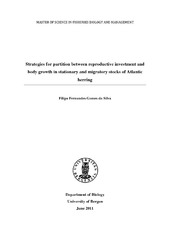Strategies for partition between reproductive investment and body growth in stationary and migratory stocks of Atlantic herring
Master thesis
Permanent lenke
http://hdl.handle.net/1956/5588Utgivelsesdato
2011-06-01Metadata
Vis full innførselSamlinger
Sammendrag
The present study focused on the trade-off between reproductive investment and body growth of migratory and stationary Atlantic herring (Clupea harengus) populations. Published data from Norwegian spring-spawning (NSS) herring, a highly migratory stock caught on the spawning grounds off the Norwegian coast, was compared with two local/stationary herring populations that spend most of their life cycle relatively isolated in semi enclosed bays (Lindåspollene and Trondheimsfjord). One third sample was also taken in Landvikvannet (southern Norway) but so far very little is known about this herring population. In Lindåspollene sampling was carried out between late January and March 2009 and 2010 and in Trondheimsfjord only one sample was taken in March 2010. The sampling in Landvikvannet was carried out in May 2010. Inside Lindåspollene two groups of herring were differentiated by otolith pattern and by bimodal age frequencies. The study compared fish condition (K), gonadosomatic index, female fecundity and body growth between these populations just before spawning. NSS herring had the highest growth rate compared to all other groups but it was also one of the groups with higher value of K while Trondheim the lowest. Migratory NSS herring presented the lowest relative fecundity together with one of the samples caught in an outside area of Lindåspollene. Overall, results from relative fecundity seem to indicate the existence of a threshold value of about 270 oocytes per gram of fish that separates the migratory populations from the stationary ones. Energy must then The present results support the findings of Atlantic herring exhibiting a large dynamic range of reproductive strategies which are in turn a reflection of population adaptations to their environment. However, to fully evaluate the whole range in reproductive tactics, the relationship between the number and the size of the eggs should be further studied.
